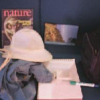Free Online Productivity Tools
i2Speak
i2Symbol
i2OCR
iTex2Img
iWeb2Print
iWeb2Shot
i2Type
iPdf2Split
iPdf2Merge
i2Bopomofo
i2Arabic
i2Style
i2Image
i2PDF
iLatex2Rtf
Sci2ools
CVPR
2006
IEEE
2006
IEEE
An Integrated Model of Top-Down and Bottom-Up Attention for Optimizing Detection Speed
Integration of goal-driven, top-down attention and image-driven, bottom-up attention is crucial for visual search. Yet, previous research has mostly focused on models that are purely top-down or bottom-up. Here, we propose a new model that combines both. The bottom-up component computes the visual salience of scene locations in different feature maps extracted at multiple spatial scales. The topdown component uses accumulated statistical knowledge of the visual features of the desired search target and background clutter, to optimally tune the bottom-up maps such that target detection speed is maximized. Testing on 750 artificial and natural scenes shows that the model's predictions are consistent with a large body of available literature on human psychophysics of visual search. These results suggest that our model may provide good approximation of how humans combine bottom-up and top-down cues such as to optimize target detection speed.
Bottom-up Attention | Bottom-up Component | Bottom-up Maps | Computer Vision | CVPR 2006 | Target Detection Speed | Top-down Attention |
| Added | 12 Oct 2009 |
| Updated | 28 Oct 2009 |
| Type | Conference |
| Year | 2006 |
| Where | CVPR |
| Authors | Vidhya Navalpakkam, Laurent Itti |
Comments (0)

